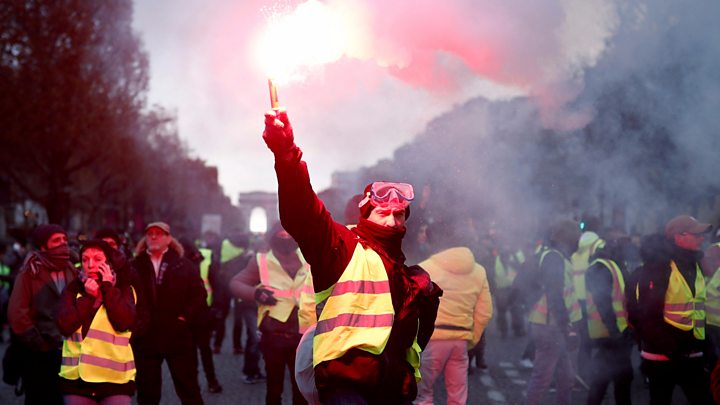
Media playback is unsupported on your device
French President Emmanuel Macron has lashed out at demonstrators who clashed with police in Paris during the latest protests sparked by rising fuel prices.
"Shame on those who attacked" officers, he tweeted. "There is no place for violence in the [French] Republic."
There was chaos on the Champs-Elysées on Saturday as police used tear gas and water cannon to disperse protesters.
The demonstrations had been billed by the "yellow vest" movement as "act two" in a campaign that began a week ago.
Named after their distinctive high-visibility attire, the protests initially focused on a rise in a fuel duty on diesel.
They later grew to reflect anger at rising living costs, particularly in rural areas, and other grievances against President Macron's policies.
More than 100,000 people took part in about 1,600 protests across France on Saturday, the interior ministry said. Most passed off peacefully - except in the capital, where 8,000 demonstrators gathered.
What happened on the Champs-Élysées?
Five thousand police had been deployed in Paris. They had set up metal barriers around the Champs-Élysées to stop protesters reaching key buildings such as the president's office and the national assembly.
A spokesperson for the demonstrators insisted that they were peaceful. "We are not here to pick a fight with cops, We just want the government to listen to us," Laetitia Dewalle told AFP news agency.
But in the morning some tried to break through the police cordon. They lit fires, tore down street signs, erected barricades, pulled up paving stones and hurled them at police while shouting slogans against Mr Macron.
The chaos continued into the evening, when police cleared most of the area.
Officials say 19 people were injured in the clashes, including four officers. Forty people were arrested.
What about unrest elsewhere in France?
Demonstrations were staged around in the country. Roadblocks were set up to slow down traffic. Some motorway toll booths were taken over to let vehicles through.
There were a number of minor clashes. Overall 130 arrests were made.
The protests and the violence were on a much smaller scale than the previous week. Last Saturday more than 280,000 people took part, two people were killed and more than 600 people injured.
How did Macron and his government react?
In his tweet the president praised the security forces for "their courage and their professionalism".
He added: "Shame on those who attacked them. Shame on those who assaulted other citizens and journalists."
French state media reported that several reporters had been attacked in the southern cities of Toulouse and Béziers.
Interior Minister Christophe Castaner accused the protesters of being influenced by the leader of the far-right National Rally party, Marine Le Pen. But she accused him, on Twitter, of dishonesty.
Why are drivers on the warpath?
The price of diesel, the most commonly used fuel in French cars, has risen by around 23% over the past 12 months to an average of €1.51 (£1.32; $1.71) per litre, its highest point since the early 2000s, AFP reports.
World oil prices did rise before falling back again but the Macron government raised its hydrocarbon tax this year by 7.6 cents per litre on diesel and 3.9 cents on petrol, as part of a campaign for cleaner cars and fuel.
The decision to impose a further increase of 6.5 cents on diesel and 2.9 cents on petrol on 1 January 2019 was seen as the final straw.
The president has blamed world oil prices for three-quarters of the price rise. He also said more tax on fossil fuels was needed to fund renewable energy investments.
Not just about fuel
Analysis by Lucy Williamson, BBC News, Paris
The spark for the protest is clear, but there's not much that unites the "yellow vests" beyond their high-visibility gear and their anger at rising taxes and living costs.
In a country where protests are often tightly managed by one political party or trade union, this is a movement with no recognised national leader, no formal structure or affiliation, which unites voters of all ages, from the far-left, the far-right, even those who once supported President Macron.
Their new co-operation is a sign that Mr Macron has failed to restore their faith in politicians, and that deep divisions remain. These are not France's most marginalised citizens, but those who say they struggle even while working, who feel they're bearing the brunt of France's economic problems, while businesses and the rich get tax breaks.
The government has blamed ultra-right gangs for the violence in Paris, but there are many peaceful citizens - both at the barricades and at home - who support the movement too.
Its diversity and democracy has been its strength so far, but also makes its ultimate vision unclear, and its membership hard to control.
Why wear yellow vests?
All drivers in France have to carry the jackets in their cars as part of safety equipment for use in a breakdown.
Along with the familiar red reflective triangle which must be placed behind a broken-down vehicle on the side of a road, the high-visibility jacket - or "gilet jaune" - must be worn by the driver outside the car.
Failure to wear the jacket after a breakdown or accident can result in a €135 (£120; $153) fine under a law introduced in 2008.
Read Again https://www.bbc.com/news/world-europe-46331783Bagikan Berita Ini















0 Response to "France fuel unrest: 'Shame' on violent protesters, says Macron"
Post a Comment